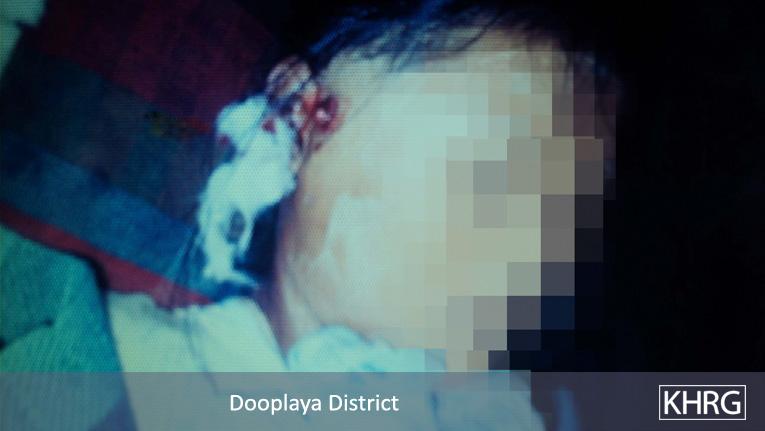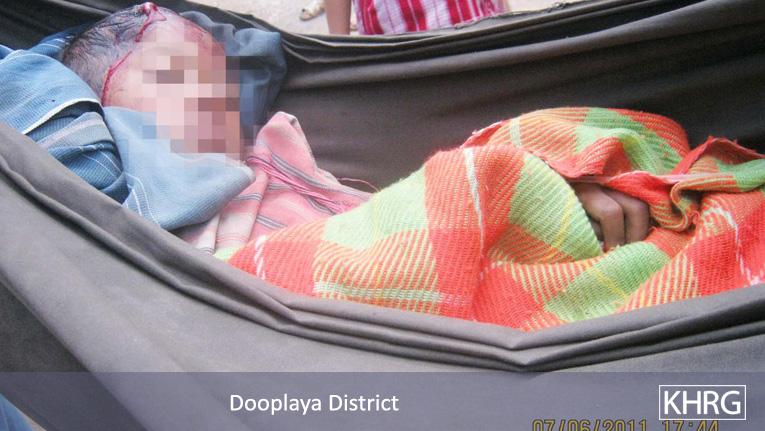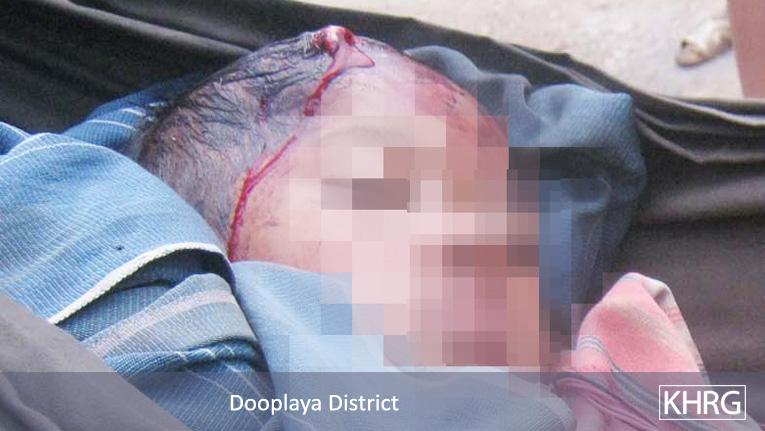On June 7th 2011, a seven-year-old child was killed and a 17-year-old child and 25-year-old woman were injured in Mae T'Ler village when Tatmadaw LIB #283 fired more than thirty 81 mm mortars into several villages, while repelling a DKBA attack on a hilltop Tatmadaw camp approximately five kilometres away from Mae T'Ler. This bulletin is based on information and photographs submitted by a KHRG researcher in Dooplaya District between June 10th and 16th 2011.
On June 7th 2011, a seven-year-old child was killed and a 17-year-old child and 25-year-old woman were injured when troops from Tatmadaw LIB #283 shelled Mae T'Ler village, Kawkareik Township, and other villages in the surrounding area, according to information submitted by a KHRG researcher. Local sources that spoke with KHRG's researcher reported that at 1:00 pm on June 7th DKBA soldiers led by Column Commander Pee Dah attacked a hilltop Tatmadaw artillery camp near Bpaw Hsih Muh village, occupied by LIB #283, with small arms, including grenade launchers and rocket-propelled grenades (RPGs). The local sources said that the fighting occurred in the immediate vicinity of Bpaw Hsih Muh camp, and reported that as the DKBA attack was repelled LIB #283 fired more than thirty 81 mm mortar shells into a wide area around Mae T'Ler, Kwih Kler, and Gkyauk Kee villages. The sources further stated that DKBA forces had not fired weapons from the areas that were subsequently shelled by LIB #283, either prior to or during the June 7th attack on the camp at Bpaw Hsih Muh, although DKBA forces do patrol the area.[1]
Underscoring the indiscriminate nature of the shelling, KHRG's researcher reported that five 81 mm shells fired by LIB #283 landed inside Mae T'Ler village, located approximately five kilometres from the site of the DKBA-Tatmadaw clash at Bpaw Hsih Muh. Another two shells landed in a building near Mae T'Ler known locally as Ei thee pya, used for religious purposes by Buddhist hermit monks. Shells also landed near Kwih Kler village, a 30-minute walk from the site of the clash; and near Hsaw Wah Law village, including along the road between Hsaw Wah Law and Gkyauk Kee village. The sources that reported this information estimated that the initial DKBA-Tatamdaw clash and subsequent shelling lasted for a total of 20 minutes.
According to villagers that spoke with KHRG's researcher, residents of Mae T'Ler fled the village to take cover in the surrounding forest when LIB #283 began shelling the area, and three villagers attempting to escape the village were struck by mortar fragments. All three were sent to Bper Kler village in Thailand's Umphang District, where local residents arranged to transport them to medical facilities for treatment.
Seven-year-old Saw Te--- was gravely wounded when shrapnel caused a bleeding wound to his head through which white matter was visible; a source that helped to send Saw Te--- to Thailand described this matter as part of the boy's brain. Saw Te--- was transported from Bper Kler to a hospital in Umphang District, where medical staff deemed his injury was too severe to treat and sent him to a larger hospital in Mae Sot District. Saw Te--- lost consciousness while en route to Mae Sot, and died shortly after arriving at the hospital.Naw Mi---, 25, another resident of Mae T'Ler, was struck by mortar fragments in her right ear, above her left eyebrow and on her left thumb while attempting to flee the shelling on June 7th. Like Saw Te---, Naw Mi--- was sent from Bper Kler to a hospital in Umphang District but could not be treated due to the severity of her injuries. She was transported to a hospital in Mae Sot District along with Saw Te---, where she received medical attention. As of June 16th, Naw Mi--- was recovering from her injuries and was visiting a medical facility in Umphang District once a day to have her wounds cleaned.
Pah No---, 17, was also injured in the shelling of Mae T'Ler. One piece of shrapnel entered the boy's left shoulder from the back and exited through the front, and another piece struck the left side of his face. Pah No--- is currently receiving treatment for his injuries at a medical facility in Umphang District. As of June 16th, he was expected to remain at the facility for one to two weeks.
A source in the Mae T'Ler area told KHRG's researcher that on June 8th, the day after the shelling, the head of Sa--- village was summoned to the Tatmadaw camp near Bpaw Hsih Muh. The source stated that the village head requested that Tatmadaw forces not shell his village, but was told that the soldiers would shell the areas within range of their camp if attacked again. The source further reported that DKBA forces remain active in the area between Bpaw Hsih Muh, Mae T'Ler, and the other communities that were shelled by LIB #283, adding that that residents of communities around Mae T'Ler were avoiding going to work in their agricultural projects while monitoring the security situation in the area, amid fears of further clashes and shelling.[2]
This photo, taken on June 7th 2011, shows Naw Mi---, 25, after she was injured by fragments from an 81 mm shell fired by Tatmadaw LIB #283 into Mae T'Ler village. Naw Mi--- was injured by shrapnel in her left thumb, above her right eyebrow and beside her right ear, and was sent to medical facilities in Thailand's Umphang and Mae Sot districts for treatment. [Photo: KHRG]
These photos, taken on June 7th 2011, show seven-year-old Saw Te---, who was severely injured in his head when Tatmadaw LIB #283 shelled Mae T'Ler village. In the photo on the right, Saw Te---'s wound is visible, including white matter that was described to KHRG's researcher as part of the boy's brain. Saw Te--- died shortly after arriving at a hospital in Mae Sot District from another facility in Umphang District that was unable to treat his injury. [Photos: KHRG]
These photos, also taken on June 7th, show Pah No---, 17, three hours after he was injured while attempting to flee shelling of Mae T'Ler village by Tatmadaw LIB #283. Pah No--- was struck by mortar fragments in the left side of his face and his left shoulder; he was sent to a medical facility in Thailand to receive treatment for his injuries. [Photos: KHRG]
Footnotes:
[1] For previous examples of civilians injured or killed by functionally indiscriminate use of mortars and small arms by parties to the current conflict in Dooplaya District, see: Displacement Monitoring Update No.75: "One villager injured by mortar, one villager beaten in Th'Waw Thaw village," KHRG, June 2nd 2011; Displacement Monitoring Update No.65: "Villager shot, houses burned during night-time DKBA attack on Waw Lay village," KHRG, March 24th 2011; Displacement Monitoring Update No.61: "Woman and 8-month-old baby injured by mortar in Htee Theh Leh," KHRG, February 22nd 2011; "Villager injured, community flees: Conflict continues to impact civilians in Dooplaya District," KHRG, November 2010; "Protection concerns expressed by civilians amidst conflict in Dooplaya and Pa'an Districts," November 2010.
[2] KHRG's researcher reported that most households in the Mae T'Ler area cultivate either hillside or flat paddy fields and explained that, in June, hill field farmers usually clear weeds and grasses from their recently-planted fields while flat field farmers till their fields to prepare for planting at the onset of the rainy season.









